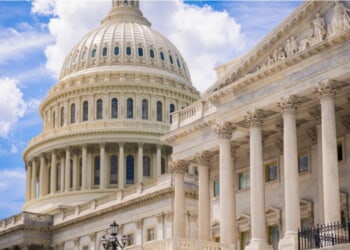Tariffs have dominated the news since Trump’s announcement of “reciprocal” tariffs in the Rose Garden. Over the subsequent week, the S&P 500 and the Nasdaq fell roughly 12 percent, and then mostly recovered yesterday in the single biggest one-day rally in over 20 years when Trump announced that tariffs on many countries would be delayed 90 days. Today, though, the market seems to have given back about half of those gains.
Despite the market volatility, Trump now has a window of opportunity to advance his America First Agenda. First, Trump may be able to negotiate lower tariffs on American goods around the world, as well as American tariffs on foreign goods. High and unfair tariff rates were the primary justification for “reciprocal” tariffs in the first place.
Clearly, most countries really want the U. S. as a trading partner. Vietnam offered to drop all its tariffs on U.S. goods within hours of Trump’s announcement. Israel said it would drop their tariff rates to zero before Trump even announced the newest round of tariffs. We hear reports of 70-plus countries lining up to “make a deal” with Trump. So far, so good.
But even more can be gained than getting other countries to lower their tariff rates. Trump has an opportunity to tear down the façade of many non-monetary barriers (NMB) to international trade. The most important NMBs relate to onerous environmental and labor regulations and reporting being imposed on U.S. companies. One of the worst culprits is the European Union and its Corporate Sustainability Due Diligence Directive. (RELATED: ‘Liberation Day’ and the Double Standard of EU Policy)
This directive requires companies to report not only their own emissions, but the emissions of their (often thousands) of suppliers and sometimes even the emissions of their customers. It also requires them to report on the working conditions of anyone in their supply chain. Some in Congress have recognized how these regulations harm American citizens and have proposed the Protect USA Act to address regulatory overreach from the European Union.
Besides retaliating with their own tariffs, China may also be the single worst offender when it comes to unfair trade practices. China has long forced technology transfers and imposed Chinese Communist Party influence on corporate boards. Trump can pressure the Chinese Communist Party by isolating their economy from the rest of the world. (RELATED: Trumping China)
China has backed itself into a corner of resistance and combativeness. Their economy, however, is on a much shakier footing than the U. S. and will suffer more in a trade war. If Trump can sign trade deals with Vietnam, Japan, and dozens of other countries, he can further isolate and weaken China. Which may lead to greater concessions from them in the end. (RELATED: Simple Math Shows That China Lacks Leverage in This Trade War)
Trump has yet to accept any offers of freer trade. Anyone who has engaged in negotiation knows that letting people sweat a little bit can increase their eagerness to close a deal. Perhaps he appears diffident in order to maximize his eventual leverage. While being coy about tariff deals may increase negotiating leverage, the strategy also has risks.
One obvious risk is that tariffs don’t end up lower than before. In this area, Trump is his own worst enemy by wanting a high 10 percent tariff across the board on all imports. High tariffs, just like any other tax, will reduce economic activity and create real economic losses. Although the U. S. economy has a better footing, the tariff war to “decouple” from China can still create significant costs, losses, and disruptions. (RELATED: America’s Tariffs: Clear Losers, but Decoupling From China)
Another risk is that uncertainty created by Trump’s tariff negotiations will cool U.S. investment. The intense uncertainty has sidelined the massive investments he has touted. Capital sitting on the sidelines, rather than building factories and machines or hiring workers, will slow economic growth dramatically. The 90-day reprieve does relatively little to reduce uncertainty. This drag on the economy will continue until the tariffs are finalized.
Renegotiating trade agreements also risks greater cronyism as various special business interests lobby for exemptions or extra protection. Finally, the greatest risk may be stoking hostility and resentment towards the United States. If foreign leaders come to believe that the U.S. is unreliable and indifferent to their well-being, they will take their business and investment elsewhere. They need the United States today, but over the next 10-20 years that can change — especially if China makes them a good offer.
Trump has bought himself some time with yesterday’s temporary delay. But he has to navigate these waters carefully. Further isolating China with the goal of having them reform their most egregious trade practices will make the world a better place. And signing trade deals, reducing tariffs to zero, while also undoing the many regulatory drags on U.S. businesses, would boost the economy dramatically.
But the longer it takes to negotiate these deals, the greater the damage to the economy. Sustained uncertainty, failure to lower tariffs and NMBs substantially, costs from decoupling with China, and growing international resentment, however, can all hamstring the U.S. economy.
The stakes of trade negotiations are quite high. Let’s hope Trump knows what he is doing and will really prioritize freer and fairer trade rather than steering us into a brave new world of tariffs.
READ MORE from Paul Mueller:
Presidents Are Not Economic Magicians





![Jasmine Crockett Justifies Mass Illegal Immigration With Bizarre Argument [WATCH]](https://www.right2024.com/wp-content/uploads/2025/03/1742007023_Jasmine-Crockett-Justifies-Mass-Illegal-Immigration-With-Bizarre-Argument-WATCH-350x250.jpg)

![NYC Tourist Helicopter Falls into Hudson River, Siemens Executive and Family Among Those Killed [WATCH]](https://www.right2024.com/wp-content/uploads/2025/04/NYC-Tourist-Helicopter-Falls-into-Hudson-River-Siemens-Executive-and-350x250.jpg)








